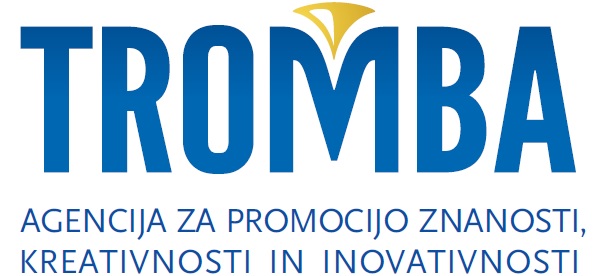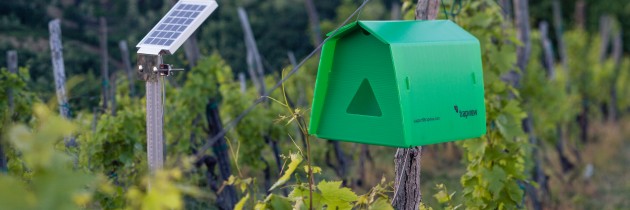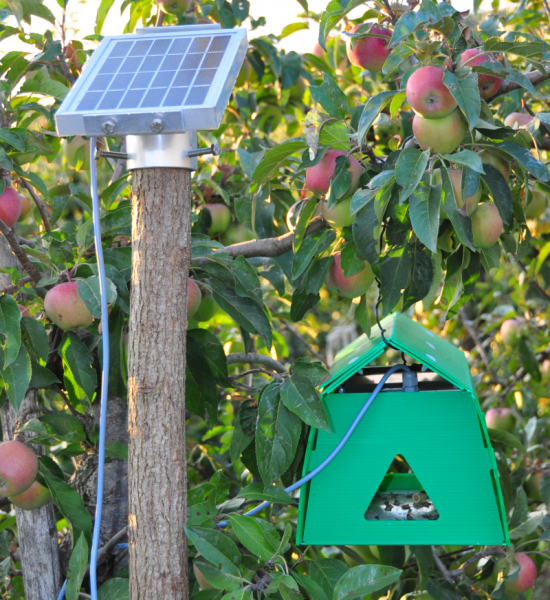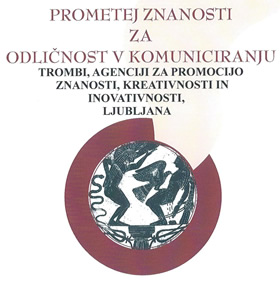Efos: Ideas aren’t expensive, but their realisation is
Throughout the developed world, healthy food is becoming the prerequisite concern for ensuring a high quality of life. The food industry, in collaboration with food producers, agricultural experts and structural policies, is seeking for ways on how to move the supply and demand in this direction. As a result, numerous start-ups are springing up that combine a vast amount of knowledge provided by various experts.
One of them is EFOS, a young Slovenia-based technology company, involved in the development of complex IT systems in the field of the environment and healthy food. Their solutions are helping several thousand users on a daily basis. But, according to Matej Štefančič the director of EFOS, a Computer and Information Science graduate, in-depth technological know-how, research and a continuous search for new solutions are vital in this process. Mr. Štefančič sat down with TROMBA to answer some questions.
With its focus on the field of environment and food, EFOS is a young technology company with solid experience in other fields;for instance,you were working on tracking animals.Would you consider that to be your beginning? How did the idea come about?
The team that is at the core of Efos was involved with software solutions connected to the environment and healthy food even before Efos. When we were launching the company, we said this would be our main field of activity. Eventually in 2009, a series of events lead us to start working on the idea how to automatize the tracking of insect pests. It has turned out that this is now our flagship product.
You spread your experience and knowledge successfully to the field of agriculture.How strong is this sector in Slovenia in terms of the production of healthy food?Is it open enough to adopt new approaches or does it insist on traditional methods?
At its core, agriculture is a conservative sector, where changes require more time to gain traction than in other sectors. This is quite understandable considering that the changing of seasons plays a crucial role in it. However, more and more people – especially those who are seriously involved in it – are carefully keeping track of relevant novelties, gradually implementing them. The Slovenian market is relatively small, which is why our products are mainly aimed at foreign markets. However, Slovenia is where we first test our new products, and the place where we have a number of people who teach us many new things. It is a pleasure to work with them.
To what extent does the structural policy favour the implementation of new approaches in the agricultural field and to what extent does it provide actual support?
I don’t think I am the right person to comment on agricultural policies. But I have noticed that there are bigger and smaller systems/producers present in this field. This means differing needs and opportunities. I guess that the services and subsidies provided by the state must be adapted to these circumstances.
Did your tech company EFOS come about while searching for a market niche or because a group of highly qualified experts was looking for a new challenge, trying to merge expertise from various fields into a completely new product?
Efos was primarily established because we wanted to fine tune the farm animal tracking system and also to design other software solutions associated with the environment and healthy food, so that we would be able to apply our know-how on this particular subject matter and technology.
New solutions, such as TRAPVIEW, came about gradually, often by chance, really. First, someone pointed out the problems caused by insect pests and inquired whether we could design a software solution to address this issue. Through conversations with almost all of our acquaintances who were relevant in this regard we came to the realisation that we would also have to automatize data capture, and that the end solution would have to come at an agreeable price. But we were far from knowing how the solution would turn out, what problems we would have to face on the way etc. Details like that became clearer along the way.
You created a whole new method and tool – TRAPVIEW is designed to determine the presence of insect pests on an agricultural area. Can you tell us more about this innovative, original project that is unlike anything that has been made before?
When we started working on it, it was still an original innovation that provided a solution to a very pressing issue in modern agriculture. However, our first competitors have already emerged and there is no doubt there will be more.
TRAPVIEW enables real-time tracking of the population of insect pests, e.g. various moths causing wormy fruit. There is an automated pheromone trap/bait set up on site, that looks like a bird feeder, which is fitted with electronics. In this way, we can make daily detailed pictures of what has been caught in the trap. The pictures are later sent to servers, together with GPS location data, via a mobile provider’s network. The pThe pThe ictures are processed and the insects are automatically recognised. Based on this information, relevant messages are generated. Users are able to view the status of the insect pest population anytime and anywhere via their mobile app. The producer is thus able to make timely and optimum pest control decisions. Modern pest control methods enable us to grow healthy fruit and vegetables that are pleasing to the eye, however, we must act within a day or two, otherwise they are far less effective. The standard approach involving manual inspections of the pests trapped is infeasible in this respect.
TRAPVIEW combines the broad knowledge of many highly qualified individuals that were working on the project.What types of expertise were required and how did you compile the team?
The key word here is interdisciplinarity. They say that if you are holding a hammer, all problems look like a nail. Unfortunately, the end result is optimum only in rare instances. Our initial project featured highly qualified electrical engineers, an agronomist, a statistic model expert, an expert for automated image capture (computer vision) and of course computer scientists and IT specialists. Most had obtained a doctoral degree, and the project was running on three continents. It may be challenging coordinating so many different people but the result can be fascinating. Today, TRAPVIEW still involves a motley crew with a vast array of expertise, and it seems to me that this is only positive.
In what fields of agriculture can TRAPVIEW be applied or adjusted to?
We started with fruit-growing, but soon found that we were actually holding a tool that can be employed in many ways by different users in line with their particular needs. Today, TRAPVIEW is used in fruit growing, wine growing, arable farming, vegetable cultivation, forestry and, last but not least, in food storage facilities.
How successful and effective is it in agriculture?Can you tell us more about it?
The main point is that it enables making appropriate decisions based on tracking the insect pest. If the system notifies you automatically and regularly of the status of the pest population, you can act at the right time and in the right place, instead of letting the situation surprise you and you act too late. As I’ve mentioned earlier, timely actions are crucial in the modern methods that are gaining ground in agriculture. Compared to the classic approach that requires manual inspection of traps/baits, automated data capture is very important as well. A significant disadvantage of the classic approach is that it depends on the human factor i.e. whether the person responsible for inspecting the traps actually goes there on the set date, because any further decisions depend on the information on how many insects were trapped. If the trap inspection date overlaps with holidays, the weekend, bad weather or even the fact that the person to carry out the on-site inspection falls ill, then it is very likely that this piece of information will be missing and the necessary actions will not be taken, even though they should. Of course, there are two other important advantages. One is the simple exchange of information and data, e.g. between the producer and the consultant, and the other is that both of them have access to view the same data/pictures. With consultants that cover large areas this means a significant cost reduction in terms of on-site visits.
From your answers I get the impression that you work on projects that benefit people.Would you say that this was the underlying motivation of the group when it tackled this high-tech project in the field of agriculture?
Our main motivation is solving intriguing problems. Contributing to healthy food and the reduced pollution of the environment is only an added bonus.
You product has not gone unnoticed abroad.How did you respond, how do you collaborate with foreign markets and how do you keep networking?
Even if you are dealing with companies, you are basically still dealing with people, and so each collaboration is a separate story. We first started collaborating with those companies we had met previously in projects involving farm animal tracking. As of late, new contacts with partners are made mostly through trade shows and our existing partner companies.
How would you describe the conditions and attitude to agricultural issues in other countries, primarily those in which you operate?
They are quite different. In fact, I think that there are countries where the prevailing mentality is that nothing is worth the effort, and those that see agriculture as the sector that everyone needs and where there is a lot of room for improvement. Of course, it wouldn’t be fair of me to make such general conclusions; even in places where agriculture is not exactly appreciated, there are individuals and companies that think otherwise and prove that hard work and commitment can make a change.
You once summed up your observations in the statement that natural conditions and the state of intelligence are in balance with each other. That sounds interesting.Could you elaborate?
The example was given by one of our clients comparing the mentality across countries. It is more about the fact that we are often content with the existing situation, where it is easier to complain that everything is wrong, than it is to think about ways to get things moving. If your surroundings provide you with a comfortable life, you don’t have to do much to make it better, even though there are so many fascinating things that could be improved. As an IT specialist, I would never have thought that I will be “counting bugs” one day. But, as it turns out, this is actually an intriguing issue in which IT can provide valuable support.
The extensive knowledge of your group propelled your breakthrough into the domestic and foreign markets.What is your take on the scope of quality knowledge in Slovenia considering the high rate of unemployment among young graduates?
I am always surprised how much knowledge there is readily available in Slovenia and how many interesting projects are under way. The problem is though that there are often not enough opportunities for people with qualifications and the desire to prove themselves to actually pull through with this. I certainly don’t think it is right that people at the age of 35 have to look for their first real job, because they were only given odd jobs up until then.
Is launching start-ups the solution, a way out of the existing situation?
I don’t know. It might. Establishing new companies doesn’t hurt, but probably it also doesn’t solve all the problems. Along with several small companies, we also lack one large enterprise (preferably from abroad considering the current situation) that would recognize how many capable people with excellent ideas and the will to realise them we have.
Would you to share any advice for those who are thinking about this?
Ideas aren’t expensive, but their realisation is. If you have an idea how to do something completely from scratch or, at the very least, how to improve on something, you should think about it thoroughly. Discuss it with as many people as you can, to get their insight. Even if they are sceptical about your idea, their feedback will make you aware of the things you should be more careful with. If your idea passes muster with your friends and you find yourself with at least one colleague who is willing to share with you success or failure, then you should go for it.








